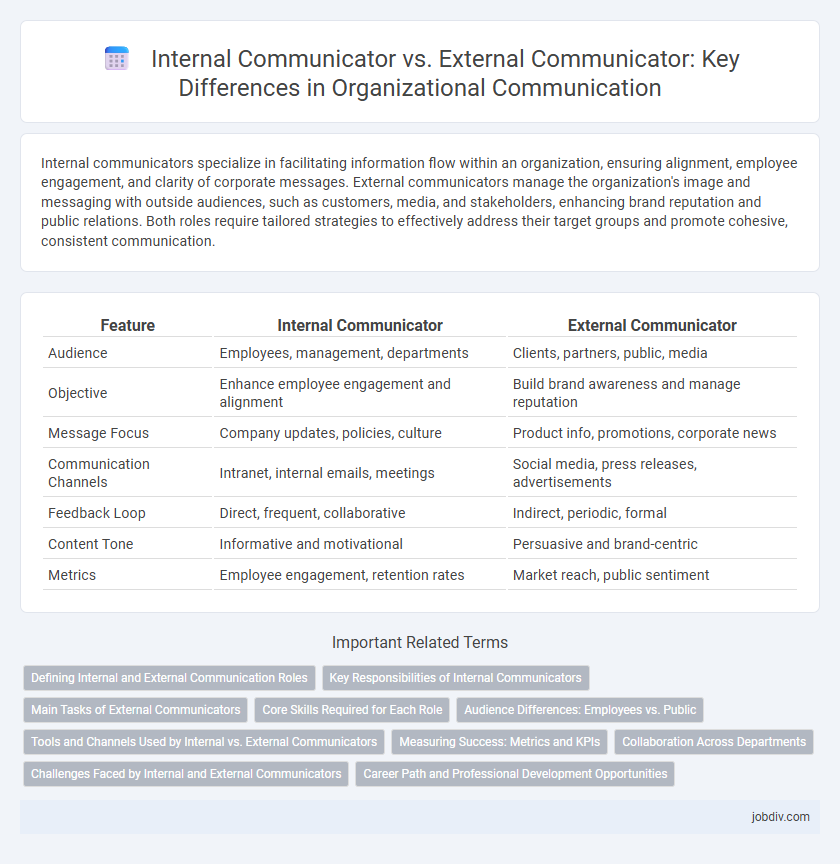Internal communicators specialize in facilitating information flow within an organization, ensuring alignment, employee engagement, and clarity of corporate messages. External communicators manage the organization's image and messaging with outside audiences, such as customers, media, and stakeholders, enhancing brand reputation and public relations. Both roles require tailored strategies to effectively address their target groups and promote cohesive, consistent communication.
Table of Comparison
| Feature | Internal Communicator | External Communicator |
|---|---|---|
| Audience | Employees, management, departments | Clients, partners, public, media |
| Objective | Enhance employee engagement and alignment | Build brand awareness and manage reputation |
| Message Focus | Company updates, policies, culture | Product info, promotions, corporate news |
| Communication Channels | Intranet, internal emails, meetings | Social media, press releases, advertisements |
| Feedback Loop | Direct, frequent, collaborative | Indirect, periodic, formal |
| Content Tone | Informative and motivational | Persuasive and brand-centric |
| Metrics | Employee engagement, retention rates | Market reach, public sentiment |
Defining Internal and External Communication Roles
Internal communicators manage the flow of information within an organization, ensuring employees remain informed, engaged, and aligned with company goals through tools like intranets, newsletters, and meetings. External communicators craft and deliver messages to stakeholders outside the organization, such as customers, investors, and the media, using press releases, social media, and public relations strategies. Defining these roles clearly enhances organizational efficiency by aligning communication channels with target audiences and strategic objectives.
Key Responsibilities of Internal Communicators
Internal communicators manage employee engagement by crafting clear messages that align with company goals and culture. They coordinate between departments to ensure consistent information flow, support change management initiatives, and facilitate feedback channels. Their role also includes fostering a collaborative environment through regular updates, training materials, and internal campaigns.
Main Tasks of External Communicators
External communicators manage public relations, media outreach, and stakeholder engagement to shape brand reputation and facilitate transparent information flow. They craft press releases, handle crisis communication, and coordinate with external partners to align messaging with organizational goals. Their main tasks also include monitoring public perception and adjusting communication strategies to enhance audience connection and trust.
Core Skills Required for Each Role
Internal communicators excel in employee engagement, conflict resolution, and knowledge management, focusing on fostering collaboration and aligning organizational culture. External communicators prioritize media relations, brand messaging, and crisis communication to build public trust and manage external perceptions effectively. Both roles demand strong writing, strategic thinking, and adaptability to convey clear, targeted messages within their respective audiences.
Audience Differences: Employees vs. Public
Internal communicators tailor messages to employees, focusing on company culture, policies, and internal updates to foster engagement and alignment. External communicators address the public, emphasizing brand image, customer relations, and market positioning to build trust and attract clients. Understanding the distinct needs and expectations of these audiences is crucial for effective communication strategy development.
Tools and Channels Used by Internal vs. External Communicators
Internal communicators primarily use tools such as intranets, email newsletters, instant messaging platforms like Slack or Microsoft Teams, and employee portals to facilitate real-time collaboration and information sharing within organizations. External communicators rely on channels including social media platforms, press releases, websites, email marketing, and customer relationship management (CRM) systems to engage with audiences, stakeholders, and the public. Both roles leverage analytics tools to measure message effectiveness, but the choice of channels depends on the target audience--employees for internal communication versus clients and the general public for external communication.
Measuring Success: Metrics and KPIs
Internal communicators measure success using employee engagement scores, message reach, and feedback loop effectiveness, while external communicators focus on metrics like brand awareness, media coverage, and audience sentiment analysis. Key performance indicators for internal communication include open rates of internal newsletters, intranet traffic, and participation in corporate events. External communication KPIs emphasize social media engagement, website traffic originating from campaigns, and conversion rates tied to communication initiatives.
Collaboration Across Departments
Internal communicators drive collaboration across departments by ensuring seamless information flow and aligning team objectives within the organization. External communicators focus on bridging the company with outside stakeholders, facilitating partnerships and maintaining brand reputation through transparent messaging. Effective collaboration requires these roles to synchronize strategies, optimizing both internal cohesion and external engagement.
Challenges Faced by Internal and External Communicators
Internal communicators face challenges such as ensuring message consistency across diverse departments, managing information overload, and fostering employee engagement in remote or hybrid work environments. External communicators struggle with maintaining brand reputation amid public scrutiny, adapting messages to varied audience segments, and responding swiftly to crisis situations on digital platforms. Both roles require strategic messaging skills to overcome barriers caused by organizational silos and fast-evolving media landscapes.
Career Path and Professional Development Opportunities
Internal communicators typically advance through roles such as corporate communication specialist, employee engagement manager, and internal communications director, which emphasize organizational culture and employee relations. External communicators often pursue career paths that include public relations specialist, media relations manager, and communications strategist, focusing on brand reputation, public messaging, and stakeholder engagement. Both paths offer professional development through certifications in communication strategy, media training, and leadership programs tailored to enhance skills in audience-specific messaging and crisis communication.
Internal Communicator vs External Communicator Infographic

 jobdiv.com
jobdiv.com